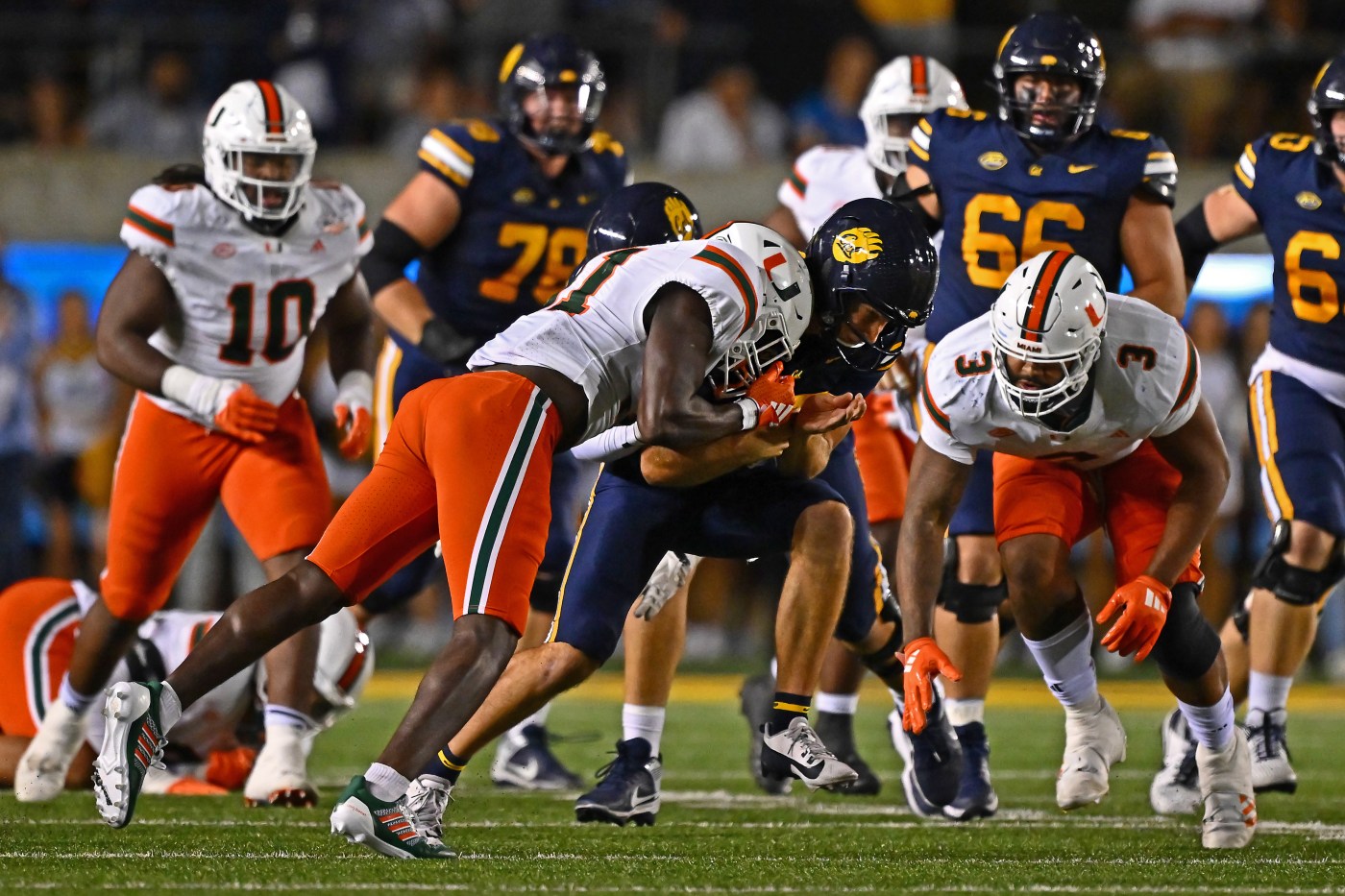A memorable 18 hours for Cal’s football program began Saturday at dawn with an epic ESPN ‘College GameDay’ broadcast from Memorial Glade and ended before midnight with an excruciating loss to Miami in Memorial Stadium.
The Bears squandered a 25-point lead in the second half and missed their chance to upset the Hurricanes.
Then again, many fans watching the riveting fourth quarter might take issue with the word squandered.
They probably would prefer the term hosed to describe what happened to the Bears during the most controversial sequence: a crushing hit on Cal quarterback Fernando Mendoza by Miami linebacker Wesley Bissainthe near midfield that looked like targeting based on the helmet-to-helmet contact that led to Mendoza briefly leaving the game.
Had targeting been called, the Bears would have been awarded a first down in Miami territory with a six-point lead and less than two minutes remaining.
But ACC officials declined to assess a penalty following the review process, and Cal was forced to punt. The Hurricanes took over with 1:42 left and promptly drove 92 yards in six plays for the winning touchdown.
Asked to comment on the controversial non-call after the game, Bears coach Justin Wilcox said: “I’m not going to talk about that.”
He wasn’t alone. In response to an inquiry from the Hotline, an ACC spokesperson provided the targeting language from the rulebook but would not expand on the specifics of the play.
Plenty of observers weighed in, however.
“I do not know by the definition of the rulebook, how that is not targeting,” ESPN analyst Brock Osweiler said on the broadcast after seeing the replay.
“I’m not saying Wesley Bissainthe did that intentionally, I think he’s just reacting, playing good, hard, tough football, but by definition, that is 100% targeting.”
Or was it?
The Hotline sought clarity on the situation using 1) the NCAA rulebook, 2) our understanding of the ACC’s replay review process and 3) a frame-by-frame look at the collision using ESPN’s video.
Here’s the bottom line up top, in our estimation: The officials could not determine conclusively that targeting occurred.
Also, the situation was more complicated than it might have appeared because there are two types of targeting infractions.
The most common involves defenseless players — a receiver attempting to make a catch across the middle, for example, or a quarterback delivering the ball while exposed in the pocket.
Targeting against a defenseless player is NCAA rule 9-1-4 and defined in this manner: “No player shall target and make forcible contact to the head or neck area of a defenseless opponent with the helmet, forearm, hand, fist, elbow or shoulder.”
But Mendoza was not defenseless; he had left the pocket and become a runner. And the threshold for targeting is different when runners are involved.
NCAA rule 9-1-3, which addresses targeting on players who are not defenseless, states the following:
“No player shall target and make forcible contact against an opponent with the crown of their helmet. The crown of the helmet is the top segment of the helmet; namely, the circular area defined by a 6-inch radius from the apex (top) of the helmet.”
That, folks, is the essential question: Did the crown of Bissainthe’s helmet make forcible contact with Mendoza?
No flag was thrown by the on-field officials. But the moment the play ended, the ACC’s replay review process shifted into high gear. The collision was examined by the head referee (Nate Black), two replay officials in the stadium and officiating experts at the conference’s state-of-the-art operations center in Charlotte.
All in all, as many as five people would have examined every angle available from ESPN’s cameras, including ACC replay supervisor Mark Bitar at the operations center.
Using a collaborative process, the quintet attempted to confirm targeting occurred.
The decision didn’t have to be unanimous, but they needed clear video evidence that the crown of Bissainthe’s helmet — the circular area 6 inches from the apex — made contact with Mendoza.
In that regard, the ACC is no different than other conferences.
Targeting is a national rule that has been discussed, analyzed and tweaked over the years in an ongoing attempt to make the game safer. (The most recent change, in 2022, allowed for an appeal process for players ejected incorrectly.) But there is no leeway for individual conferences to adjudicate the rule as they see fit.
Related Articles
CFB media: Analyzing Pac-12 TV ratings on The CW (and what it means)
What the upcoming Big Ten-SEC meeting means for college football (now and in the future)
Pac-12 bowl projections: WSU to the Alamo, Colorado to the Holiday and our breakdown of Oregon State’s difficult path ahead
CFP projections: 4 bids for SEC, 3 for Big Ten after Week 6 upsets
Best of the West rankings: Oregon is No. 1, Washington and ASU rise
The camera angle shown most often by ESPN after the collision was from behind Mendoza. In that shot, Bissainthe, who approached from the right, clearly dropped his head and made helmet-to-helmet contact with the area near Mendoza’s right earhole. And Mendoza’s head instantly jerked in the opposite direction.
Violent? Absolutely.
Helmet-to-helmet? Definitely.
Targeting? Not necessarily.
Had Mendoza been defenseless, it would have been an obvious penalty because of the helmet-to-helmet contact.
But because he was a runner, the narrow definition applies: It had to be forcible contact using the crown of the helmet.
Based on the outcome of the review process, it’s safe to assume that none of the available replays produced indisputable video evidence that the crown of Bissainthe’s helmet made contact with Mendoza.
That explanation won’t satisfy frustrated Cal fans, particularly those still irked by a phantom offsides call ACC officials made against the Bears in their loss at Notre Dame two years ago. (The blown call resulted in a touchdown for the Irish in what became a 24-17 victory.)
But it’s the only answer that makes sense.
Football has often been called a game of inches. In this case, it seems, the critical inches were on the helmet, not the field.
*** Send suggestions, comments and tips (confidentiality guaranteed) to wilnerhotline@bayareanewsgroup.com or call 408-920-5716
*** Follow me on Twitter/X: @WilnerHotline












